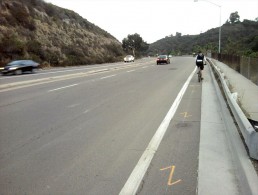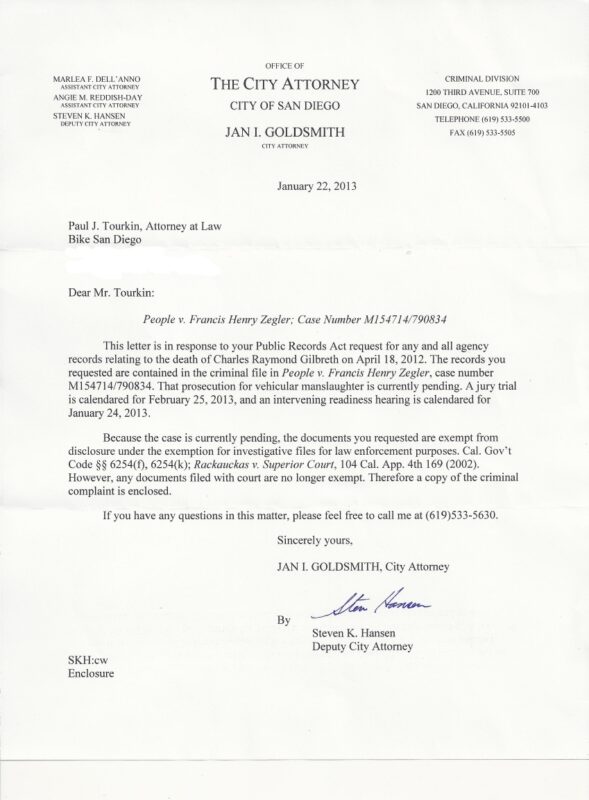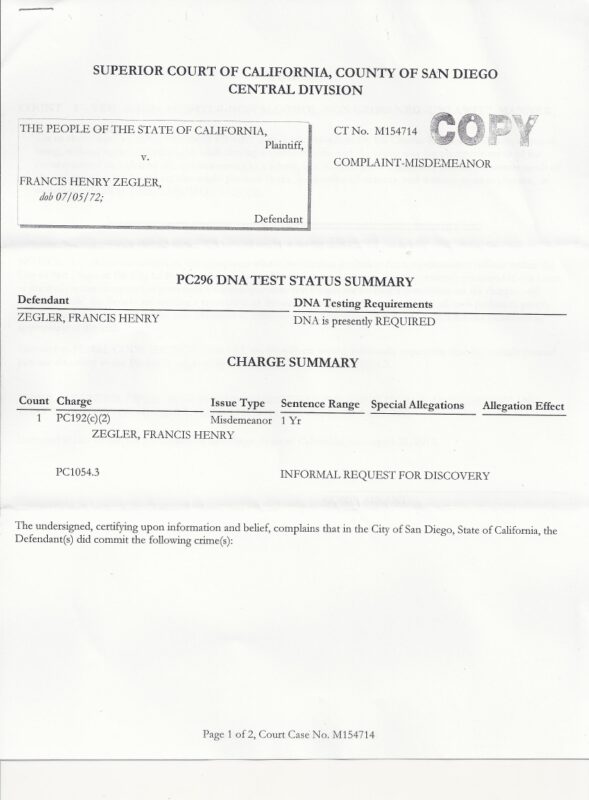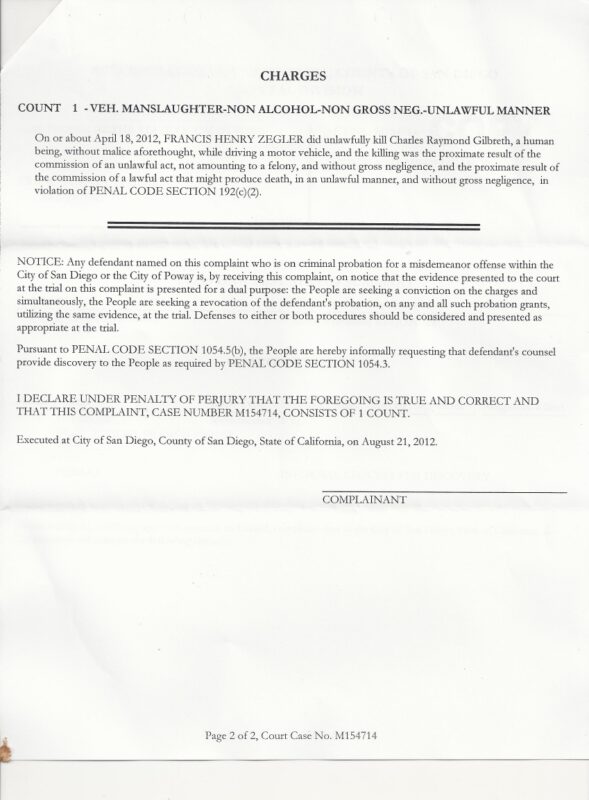The Battle for Montezuma
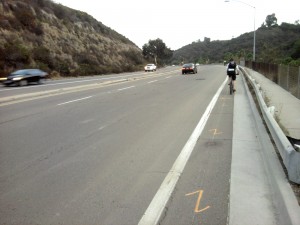
“Montezuma between Fairmount and El Cajon looks like a freeway and drives like a freeway for the western segment.” That was the description Brian Genovese, City of San Diego’s Senior Traffic Engineer for the Multimodal Program gave at last Wednesday’s College Area Community Council meeting. Unfortunately, that’s the way it may remain if other members of the Multimodal Program decide to stick with their track record of upholding the status quo. As he pointed out, the City of San Diego Bicycle Master Plan designates a Class II Facility along Montezuma which, by current standards, already exists.

Nonetheless, the crash data from 1999 - 2012 presented at the meeting confirmed what the audience was already aware of: Montezuma Road is not safe. BikeSD representatives, the CCAC, various members of the community and Brian Genovese himself all agreed that the current state of Montezuma is unacceptable. The biggest problem was identified as speed of motor vehicles.
When Genovese’s division tried an experimental approach to creating a safer cycling environment by installing a green painted section along Montezuma leading to the intersection with Collwood, many were excited to see this use of innovative new treatments. However, after four months of mounting opposition from within the City’s Traffic Engineering Section, much of the paint was removed. This defeat is representative of the current disaccord among engineers in the Multimodal Division. The Division at present lacks any type of consensus on a forward-thinking, broad-based progressive approach to dealing with capital improvement projects and instead adheres to a myopic view of individual endeavors.
Genovese vowed to continue in his fight for improvements along Montezuma using low-cost, low-effort strategies. These strategies refer to going after what he called “the low-hanging fruit”. According to Genovese, there are a large number of capital improvement projects currently underway that involve asphalt overlay, or repaving and re-striping roads. By simply identifying the opportunities to realign the paint on these streets in accordance with the City’s Bicycle Master Plan and current accepted guidelines for lane widths and design treatments, new and/or better bike lanes are able to be added at no additional cost.
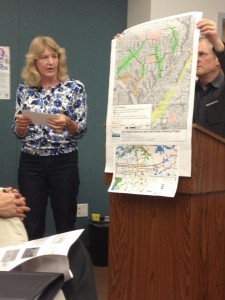
Many attendees of the CACC meeting expressed doubts about the prospect of anything actually being implemented along Montezuma Road. Brian Genovese assured the audience that San Diego was ripe for change and likening the current momentum of the cycling movement to a juggernaut. Meanwhile, this proclamation seemed to be reaffirmed by Kensington-Talmage Planning Group member Joan FitzSimons’ announcement of a planned greenbelt along Fairmount Avenue connecting the San Diego River Watershed and Chollas Creek Watershed. The City of San Diego and the City Heights Community Development Corporation have filed an application for a $300,000 CalTrans grant. This regional pilot project would implement the Complete Streets Act and span from the I-8 Freeway all the way to 47th Street, traversing seven different communities and supporting multimodal transport as well as healthy, sustainable and green communities. Plans include a linear parkway with separated bike facilities and tree-lined corridors.
Juggernaut or not, the cycling community now has the attention of planning groups, traffic engineers, city council members and even the Mayor’s office. It’s up to us to hold them accountable and make sure they follow through with transforming San Diego into the world’s best city for bicycling.
Edit: To view the entire presentation that was presented at CACC, click this pdf link.
Correction, March 22, 2013: This post has been updated to reflect the fact that the $300k grant has been applied for but not yet received. It has also been updated to show that the applicants are The City of San Diego and the City Heights Community Development Corporation and the boundaries of the project are I-8 and 47th Street. Thanks to Randy Van Vleck for providing this information.
Tonight: City to Present Early Action Striping Modifications for Montezuma Road
Tonight's College Area Community Council meeting has an item on its agenda that is of importance to us: city staff will be making a presentation about their plan for early action striping modifications on Montezuma Road to improve bicycle safety along the corridor from Fairmount Avenue to El Cajon Blvd.

The presentation will be at the College/Rolando Public Library located at 6600 Montezuma Road, San Diego, CA, 92115 and the meeting is scheduled to begin at 7pm.
We're hoping that today's presentation has taken the recommendations made by the College Area Community Council and our supporters from last November into consideration.
Progress on North Park - Mid City Bike Corridors Project
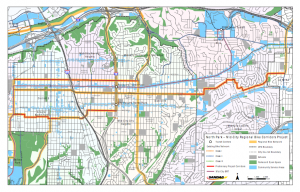
Over sixty community members were in attendance at last Wednesday’s North Park - Mid City Bike Corridors Project Community Advisory Group meeting at Sunset Temple. Project manager Bridget Enderle kicked things off by thanking everyone for coming out and participating. Enderle pointed out that the number of people attending this series of meetings was an indicator of the recent increase in support of cycling infrastructure in the community.
After introductions, Enderle outlined goals of the project and stated that the biggest concern is safety and the creation of streets where people will feel comfortable riding a bike. She added that SANDAG intends to construct three parallel corridors using innovative solutions to facilitate cycling for everyday trips, but stressed that these “vibrant livable streets” should be places for everyone and serve as an asset to the whole community, including non-cyclists.
This being the second Community Advisory Group meeting to address the North Park - Mid City Project, updated project goals were also outlined. These included the implementation of complete streets, traffic calming and end-of-trip facilities, as well as providing direct access to schools, transit, community destinations and commercial centers.
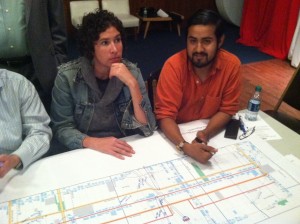
Hired consultant Matt Benjamin of Fehr & Peers was then introduced. Benjamin discussed the progress achieved in site visits of the study corridors from the preliminary alignments. Next, the community members were split into smaller groups to discuss specific sections of the proposed corridor alignments. These included Meade Ave, Howard Ave/Orange Ave and Landis St/Wightman St, all outlined in red to show proposed routes. Noticeably absent were most of University Avenue and all of Adams Avenue - two main east/west thoroughfares. The presentation shown at the meeting is available at SANDAG's Keep San Diego Moving website.
Group members were asked to give opinions on the preliminary alignments. While some offered opinions of certain routes such as Orange Ave versus Polk Ave, others suggested different routes altogether. After mapping out preferred alignments, the smaller teams were given the opportunity to present their findings to the whole group. Many interesting designs were suggested, but the overwhelming consensus was the importance of constructing cycle tracks on El Cajon Blvd.

BikeSD certainly supports any efforts toward creating a more bike-friendly San Diego and we recognize the immense opportunity of SANDAG’s Bike Corridor Projects and the nearly $2 million budget for planning and preliminary design. While neighborhood greenways are nice for a peaceful ride, we feel that in order to take full advantage of the TransNet half-cent sales tax funding and achieve the outlined goals of the project, the installation of protected bike lanes along El Cajon Blvd is the most viable option. In order to give all community members safe, convenient, direct access to the places they work, live, shop and play, pushing bikes onto side streets where they must navigate through confusing twists and turns does not make sense. As community member Hans Wangbichler stated, the bike corridor “should take people to where there is actually something.”
The next meeting will take place in May and will consist of a community workshop to address alignment and design alternatives. Let’s hope to see a big red line on the map outlining El Cajon Blvd.
Correction, March 12, 2013: This post originally stated that Matt Benjamin works as a consultant for Alta Planning + Design. He works for Fehr & Peers Transportation Consultants. This post also stated that El Cajon Blvd and University Ave were not highlighted in red. El Cajon Blvd was highlighted as an alternative to Mead Ave on one of the maps and a small portion of the eastern end of University Ave was highlighted as an alternative to the Howard Ave/Orange Ave corridor.
En Español: Progreso en el Proyecto de Corredores de North Park - Mid City
Más de sesenta miembros de la comunidad asistieron a la junta del Grupo Consultivo Comunitario sobre el Proyecto de Corredores Ciclistas de North Park - Mid City el miercoles pasado en Sunset Temple. La Directora del proyecto, Bridget Enderle, comenzó por agradecer a todos por venir y participar. Enderle señaló que el número de personas que habían asistido a esta serie de juntas es indicador del aumento del apoyo de infraestructura del ciclismo dentro de la comunidad.
Después de la introducción, Enderle identificó las metas del proyecto y afirmó que la preocupación más grande es la seguridad y la creación de calles dónde la gente se sienta cómoda para andar en bicicleta. Agregó que SANDAG planea construir tres corredores paralelos utilizando soluciones innovadoras para facilitar el ciclismo en viajes cotidianos, pero insistió en que estas “calles habitables vibrantes” deben ser lugares para todos y deben servir como recurso para la comunidad entera, incluso los no-ciclistas.
Siendo la segunda junta del Grupo Consultivo Comunitario que aborda los Proyectos de Corredores Ciclistas de North Park - Mid City, se resumieron las metas actualizadas del proyecto también. Estas incluían la implementación de calles completas, pacificación del tráfico e instalaciones para el fin del viaje, además de la provisión de acceso directo a escuelas, tránsito, destinos comunitarios y centros comerciales.
Entonces presentaron al consultor contratado, Matt Benjamin de Fehr & Peers. Benjamin habló sobre el progreso logrado en visitas a los sitios de los corredores y el estudio de los alineamientos preliminares. Luego, los miembros de la comunidad se dividieron en grupos más pequeños para hablar sobre secciones específicas de los alineamientos propuestos para el corredor. Estos incluyen Mead Ave, Howard Ave/Orange Ave y Landis St/Wightman St, todos resaltados en rojo para indicar las rutas propuestas. Notablemente ausente fue la mayoría de University Ave, y todo Adams Ave - dos rutas principales de este a oeste. La presentación que se mostró en la junta está disponible en la página web de SANDAG Keep San Diego Moving.
Se pidió que los miembros del grupo compartieran sus opiniones sobre los alineamientos preliminares. Mientras algunos ofrecieron sus opiniones sobre ciertas rutas como Orange Ave versus Polk Ave, otros sugirieron rutas totalmente diferentes. Después de indicar los alineamientos preferidos, se dio la oportunidad a los grupos pequeños de presentar sus conclusiones al grupo entero. Se sugirieron muchos diseños interesantes, pero la opinión general fue la importancia de la construcción de bicicarriles en El Cajon Blvd.
BikeSD definitivamente apoya cualquier esfuerzo hacia la creación de un San Diego más apto para el ciclismo y reconocemos la inmensa oportunidad de los Proyectos de Corredores Ciclistas de SANDAG y el presupuesto de casi $2 millones de dólares para el planeamiento y el diseño preliminar. Mientras las vías verdes que atraviesan los barrios son buenas para una vuelta pacífica, nosotros sentimos que para aprovechar el impuesto TransNet de medio centavo sobre las ventas y lograr las metas indicadas del proyecto, la instalación de carriles protegidos para bicicletas es la opción más viable. Para proporcionar a todos los miembros de la comunidad acceso seguro, conveniente y directo a los lugares en donde trabajan, viven, compran y juegan, empujar las bicis a las calles laterales dónde tienen que navegar altibajos no tiene sentido. Un miembro de la comunidad, Hans Wangbichler afirmó que el corredor ciclista “debe llevar a la gente adonde realmente haya algo.”
La próxima junta tendrá lugar en mayo y consistirá en un taller comunitario para abordar el alineamiento y los diseños. Esperemos ver un mapa con El Cajon Blvd resaltado en rojo.
Corección, 12 marzo, 2013: Esta publicación originalmente decía que Matt Benjamin trabaja como consultor para Alta Planning + Design. Él trabaja para Fehr & Peers Transportation Consultants. Esta publicación también decía que El Cajon Blvd y University Ave no fueron resaltadas en rojo. El Cajon Blvd fue resaltada como alternativa a Mead Ave en uno de los mapas y una porción pequeña del lado este de University Ave fue resaltada como alternativa al corredor Howard Ave/Orange Ave.
City to Pursue Vehicular Manslaughter Charges Against Driver who Killed Chuck Gilbreth
Last June we learned that the SDPD investigators had recommended criminal charges against the driver responsible for the death of Chuck Gilbreth.
The City is now pursuing vehicular manslaughter charges against Francis Henry Zegler, the driver who killed Gilbreth. A jury trial is scheduled for February 25th.
Below is a copy of the letter from the City Attorney's Office to us, along with the summary of charges.
We don't have any more information but will keep you updated as we learn more.
Next Wednesday (1/30): SANDAG is Seeking Your Input in Making Mid-City More Bike Friendly
While SANDAG actively solicits input to implement projects in the Uptown area, the Mid-City community now also has an opportunity to offer ideas and advocate for projects next Wednesday. Recommendations on where SANDAG can best implement projects on the ground can be offered at:
City Heights Wellness Center
4440 Wightman Street, Suite #200
San Diego, CA 92105
January 30, 2013 – 6:00 to 8:30pm at the
RSVP by email: Bridget.Enderle@sandag.org
The meeting invite went out to all the Community Group members in the Mid-City community (which includes North Park, Normal Heights, City Heights, Kensington-Talmadge and others) who have expressed an interest in being a part of the Community Advisory Group to improve bicycling conditions in the Mid-City Community. The dividing line between the Uptown Project and the Mid-City Project is Park Boulevard. So if you live east of Park Boulevard - your input is needed. While the meeting is open to the public and the public is invited to offer input, the Community Advisory Group representatives will have a seat at the decision making table.
According to the Project Manager, Bridget Enderle, the map below is a map of the project's preliminary study corridor and is one of the first of the Regional Bike Plan's high priority projects to begin the planning phase.

Do you want cycletracks on University Avenue, El Cajon Boulevard, 30th Street, Adams Avenue? Then come out and speak up.

